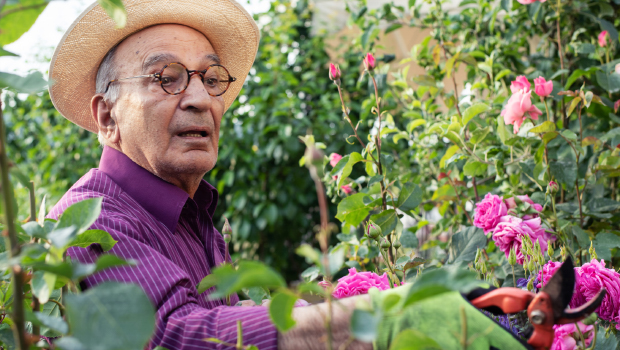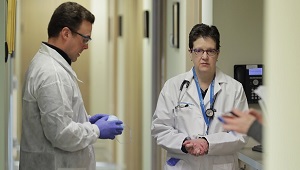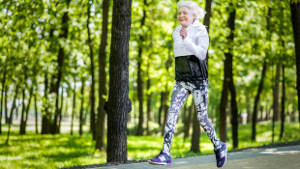How seniors can build resilience during pandemic

Older people must guard against social isolation, as well as COVID-19, to stay well and thrive, writes Dr. Eric B. Larson
By Eric B. Larson, MD, MPH, a senior investigator at Kaiser Permanente Washington Health Research Institute (KPWHRI), where he conducts research on healthy aging, prevention of Alzheimer’s disease and cognitive decline, and health services. He was formerly the executive director of KPWHRI and vice president for research and health care innovation at Kaiser Permanente Washington.
With death rates from the novel coronavirus now highest among the oldest members of our communities, I find myself drawn to stories of the exceptional. Google the words, “Centenarian survives COVID-19,”and you find many stories of people age 100 and up who were diagnosed with the dreaded disease, struggled through it, and came out the other side. These are rare instances, to be sure; that’s why they’re in the news. But it does happen, causing us to wonder: Where does such resilience come from? Like so many things about COVID-19, it’s too soon to tell. Scientists are only beginning to understand how it manifests, how to treat and prevent it, and how a vaccine might eventually lead to its eradication.
Fortunately, we are learning how to slow its spread—knowledge that’s essential for protecting those at highest risk. We also understand how to prevent the health conditions that can make COVID-19 more dangerous—problems like high blood pressure, diabetes, lung disease, and obesity. And we understand the importance of avoiding stresses made worse by the pandemic—issues like social isolation, anxiety, and depression.
Prior to the pandemic, I wrote a book about healthy aging, encouraging older adults to follow a “PATH” to resilience. With COVID-19 in our midst, the acronym still applies, especially as we strive for resilience during a time of social distancing. Let me explain.
“P” stands for “proactivity,” which means taking charge of your health and health care. In the age of COVID-19, this requires not being passive, waiting for others to suggest protective measures. We know we must stay away from large social events, keep our distance (6 feet) from others, and wash our hands frequently. We proactively avoid spreading germs by wearing a face mask in public. And we ask others for help such as shopping or running errands when we need it.
Being proactive also means telling friends, family, and health care providers what kind of care you would want in the event of serious illness. Because of the pandemic, more people are taking steps to complete advance directives, which outline their wishes in the event of a terminal illness—a wise and welcome development from the otherwise disastrous consequence of the pandemic.
“A” stands for “acceptance,” an approach that allows people to accept changes with equanimity, rather than denying the reality of a challenging situation. The COVID-19 pandemic is an unexpected epochal event for people worldwide, and especially for seniors. By accepting, rather than rejecting the facts, we’re in a better spot to find positive purpose and meaning—even in the most difficult times. We might ask, “How can I help others to cope?” This could motivate you to phone a friend who is feeling isolated. Or you might ask, “How can I best use this time?” Often the answer is something creative, like planting a garden, writing a letter, doing art. Or it may be something more pragmatic, like cleaning or organizing, getting rid of extraneous piles, and keeping what’s valued.
“TH” stands for “three”—as in “three ways to build your reserves: mentally, physically, and socially.”
1. You can build mental reserves by keeping your mind positively engaged through activities like reading, doing puzzles, or playing virtual card games with friends. Social media like Facebook or Twitter can also be engaging but be wary of focusing exclusively on issues that make you feel angry or sad.
It’s natural to think about things we’re missing during periods of social distancing—graduations, religious services, weddings, funerals, and family gatherings. You might find yourself dwelling on such losses; one’s mind can take flight, causing sad thoughts to become self-perpetuating. Such disappointments can turn into a deeper sense of misery. Through mindfulness, however, you can recognize potentially troubling thoughts as they arise and understand that they are only that—just thoughts. Rather than letting negative thoughts spin out of control and become self-reinforcing, you can step back and observe what your brain is doing. If you recognize these are just thoughts, you can use them as a trigger to acknowledge uncomfortable feelings and then find ways to comfort yourself through nurturing activities such as reading a beloved poem, saying a prayer, getting some invigorating exercise, or calling a friend to share your experience. By all means, don’t deny your emotions, but don’t wallow in them. And if you find that you’re experiencing especially severe or long-lasting feelings of sadness and isolation, reach out to a therapist or counselor for help.
2. Build physical reserves through exercise, which can be challenging for those who typically go to a gym or group classes. Ask yourself, “What activity can I safely do for 30 minutes twice a day?” You might take a brisk walk outdoors or around your residence. Avoid prolonged sitting. Stand up and move at least once an hour. You might exercise along with online videos, like this one from the National Institute on Aging. I’ve always liked the Royal Canadian Air Force workout, which can also be found online and is reportedly a favorite of Ruth Bader Ginsburg and Kate Middleton, to name just a few. NIA also provides motivational tips.
3. Build social reserves—even as you limit contacts outside your household. Some have suggested we reframe “social distancing” as “distantly socializing.” The point is we need to connect with others more, not less—even as we keep apart physically.
The pandemic may be just the excuse we need to learn more about technologies such as Facetime on our iPhones or setting up an online group meeting via software such as Zoom.
I’ve watched my wife and 6-year-old grandson in their new ritual—reading books aloud to each other online. A colleague tells me she’s enjoying a weekly online trivia games with her siblings and their kids. And I notice old friends are using the pandemic as an opportunity to write or phone, saying, “I’ve been thinking of you. I want you to know I care.”
I’d encourage everyone who’s staying home these days to make at least one such social connection each day. And do your best also to keep your body and mind active. Together, such efforts may provide just the boost you need to stay resilient during a very difficult time.
research

Coronavirus vaccine trial now includes older people
Led by Dr. Lisa A. Jackson, first-ever trial of any experimental vaccine candidate for COVID-19 virus has expanded.
notes from eric

No magic bullet to prevent Alzheimer’s, but encouraging healthy behaviors could be key
aging & geriatrics

Personalizing care when life expectancy is short
Dr. Eric B. Larson explores how prevention, testing, and treatment must be tailored to meet the needs of patients in late life.


